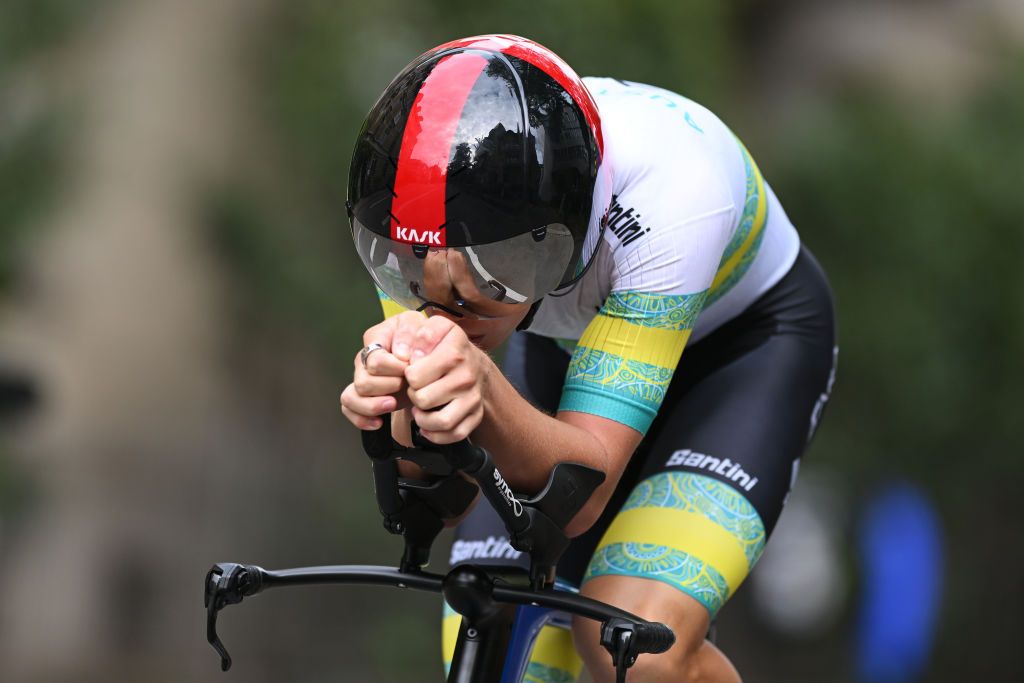Rosie Brennan strode east on roller skis along Rabbit Creek Road in South Anchorage, navigating stones, passing vehicles and an unrelenting uphill. It was a volume day in late September, and she had a long way to go.
Brennan, 35, among the top cross-country skiers in the world in recent years, marks time differently than most. Monday, Tuesday and Wednesday translate to power day, interval day and volume day on her calendar. Her training-centered lifestyle is specific to the elite in her sport, and it hardly lets up all year long as she works with APU Nordic Ski Center’s University Elite team.
“The volumes that you have to train now to be competitive are high enough that you can’t really let down ever,” Brennan said.
:quality(70)/cloudfront-us-east-1.images.arcpublishing.com/adn/NICJZ6E2Q4BFPPA23JB5VXUYZA.jpg)
In her 13th professional skiing season, she has evidence the plan works. Following in the tracks laid by other world-class APU skiers, including Olympic gold medalist Kikkan Randall, she has become the standard-bearer at APU and a standout on a U.S. national team with high expectations. She has 12 podium finishes and two wins on the World Cup circuit, the sport’s international major leagues. She has finished in the top 10 in World Cup season overall standings three times. She’s a two-time Olympian who narrowly missed the podium in a sprint race in 2022.
:quality(70)/cloudfront-us-east-1.images.arcpublishing.com/adn/RIZY67EZQ54OKAHI7Z6JCATX7A.jpg)
According to her coach, she just keeps improving.
“Every year’s better,” said APU University Elite Team head coach Erik Flora. “Right now she’s skiing faster than she’s ever skied, and she’s skiing with better technical work … the highest fitness, the highest strength.”
It took some time to hit her stride. Brennan, from Park City, Utah, recalls a rude awakening when she joined APU after her Dartmouth College skiing career. APU’s Nordic Ski Center is not an intercollegiate sports program but one focused on development, often for the world stage. Her life involved little more than training, eating and sleeping after she joined. “It was not possible to do anything else,” she said. “I was so tired.”
Doubt crept in when she didn’t find much payoff in the first few seasons. She wasn’t selected for the 2014 Olympic team, and she called her results disappointing at U.S. championship races back then. In 2014, she informed Flora that she was leaving APU to return to Utah.
:quality(70)/cloudfront-us-east-1.images.arcpublishing.com/adn/VC254SLTQVBGPHHY6MKUP6D6Q4.JPG)
Before long, she reversed course once more, fueled by an epiphany she said she had as she traveled back to Alaska for a visit.
“APU offers me literally everything I need to be successful. There is nothing that it’s not offering me,” she thought to herself on the plane north. “This is just my choice, whether I choose to make this work or not.”
“I landed and immediately called Erik and I was like, ‘I’m coming back,’” she said.
Flora said he noticed her renewed focus, and results mostly trended upward in the decade that followed. Recently, Brennan and Flora shared insight into what the grueling life entails and how she built a career that may have even more big things in store.
Speed, intensity, volume. Repeat.
Brennan’s ski training regimen is the result of her collaboration with, and her trust in, Flora, she said. The coach’s credentials are impressive. In his tenure as APU’s Elite Team head coach, which began in 2006, APU has become a reliable talent pool for the U.S. national team. Six of its skiers were named to the U.S. Olympic team in 2022 and 10 in 2018. Currently, seven of the 18 skiers named to U.S. cross-country skiing’s A and B teams train at APU Nordic Ski Center under Flora.
:quality(70)/cloudfront-us-east-1.images.arcpublishing.com/adn/BGHGSJJPIRHXPH67VF7GMCJMSU.JPG)
:quality(70)/cloudfront-us-east-1.images.arcpublishing.com/adn/L5SZQ2R66RBFBOWIAHX2WOX67Y.JPG)
Different training days hone different “energy systems,” he said. Endless refinements are made for individual athletes, but the framework is fairly consistent.
Mondays are sprint days. Typically, athletes might ski from 30 to 35 kilometers in a morning session. The sprinting happens on about 10 hills, each tackled at 45 seconds to a minute at a time in a tank-emptying race pace, Flora said.
“It’s a hard zone to be in. A lot of lactate, lot of burning,” Flora said. “It doesn’t sound like much — 10 hills. It’s a lot.”
A second training session happens later that day.
Tuesdays are for intensity and interval work, a gear that is below race pace but still builds endurance. A 10-minute course repeated six times is a common workout. Volume skiing — think 40 to 60 kilometers — happens on Wednesdays at a more relaxed pace. A variation of the early week workouts is then repeated on Thursday, Friday and Saturday.
Typical training weeks can range from 200 to 300 kilometers of total skiing, Flora said, sometimes more, plus a few non-skiing workouts.
:quality(70)/cloudfront-us-east-1.images.arcpublishing.com/adn/PV6UZZ2TLBELXGLNAMM7YYT5XY.jpg)
Sundays are rarely a day off, but athletes get latitude to choose their own adventure. That might be biking, trail running, rowing or skating. “We try to strike a balance where it’s adding to their life energy, not taking away from it,” Flora said.
“We’re probably training 48-49 weeks of the year, and seven days a week for the most part,” he said.
On a recent Friday, the APU University Elite squad gathered in high-visibility vests for interval training on roller skis in a hilly South Anchorage neighborhood. After a long warmup, Brennan and the other athletes circled the streets. The orange pylons set at the roadside marked the points at which they detonated into a fury of kicking and ticking across the pavement. Flora offered a pointed technical assessment along with generous servings of positive encouragement.
:quality(70)/cloudfront-us-east-1.images.arcpublishing.com/adn/2PEBMV55CRAEDNHAX4QLML2V2I.JPG)
APU skiers with high aspirations are playing a long game. “I think if you’re going to have somebody ski at the top of the world, it’s not a one-year project or a two-year project. It’s more a 10-year project,” Flora said.
Both Brennan and Flora say the ski training opportunities afforded by Anchorage are hard to beat thanks to its long winters and extensive trail system. That’s enhanced by APU’s Thomas Glacier Training Center on Eagle Glacier above Girdwood, through which skiers gain access to snow in summer, though it has been closed for a few years for reconstruction. The team also travels to Utah for training camps at higher altitudes each October.
:quality(70)/cloudfront-us-east-1.images.arcpublishing.com/adn/D52VK3K67JAVFPLPSGUSSKKWIQ.JPG)
Carrying a load
It’s vital to be strong. That’s universally accepted at Brennan’s level of cross-country skiing expertise. Exactly how strong, and in what way, is a trickier recipe.
“When you’re traveling on the World Cup (circuit), it’s the thing that’s the most wildly different between athletes and countries,” she said.
Brennan’s approach is that strength training should complement her time on skis, not replace it.
“To me, it’s not worth putting all my eggs in that basket. I definitely want to be strong and I definitely want to use it as injury prevention, but outside of that there’s just not a lot of evidence as to it making the difference between second and first,” Brennan said.
Brennan’s plan comes from her consultation with Tschana Schiller, director of sport science for action and endurance for the U.S. Ski and Snowboard Association.
Strength training sessions coincide with interval skiing days, Tuesdays and Fridays. The lifting session happens at a brisk pace. Brennan said a typical weight room visit involves about 10 moves — squats, deadlifts, bench rows, bench presses and hip extensions commonly among them. Her best, she said, is probably weighted pull-ups. Plyometric moves, like jumps and hops, are sprinkled in to benefit speed and coordination. It’s all generally wrapped up in 75 minutes or less, she said.
:quality(70)/cloudfront-us-east-1.images.arcpublishing.com/adn/MPINCQ46TVBERPE7GXPD34QJ4I.JPG)
Her most intense weight training happens in summer, she said. The goal is to build up strength before she hits the road for the World Cup season, when time and access to facilities become less predictable.
“The hope is that when I leave for Europe, I’m at my max strength because it’s also hard to maintain it throughout the winter,” she said.
Fueling her passion
Though Brennan is under the watchful eye of experts on the ski trails and in the weight room, that’s not the case in the kitchen. Though she has worked with various national team nutritionists, her diet is mostly self-managed.
It helps, then, that she takes a keen interest. Brennan said nutrition-related pursuits could one day follow her athletic career, though she’s had no formal education in it yet. She got serious about what she eats in 2018, she said, a year in which she had mononucleosis.
“Afterwards I became really interested, not because I think I had poor nutrition, and that’s what gave me mono,” she said. “But I think it just gave me an awareness of overall well-being that I hadn’t really considered before.”
Her guiding principle — eating unprocessed “whole” foods — seems simple but requires time and effort. Brennan leans heavily on food she prepares from scratch. She makes her own granola and bread. She eats vegetables from her garden. A significant amount of the protein she consumes comes in a most Alaskan way: In June she setnets for sockeye salmon during a personal-use fishery on the Kasilof River. It’s a solution that helps her stretch her dollars.
Leftovers become her lunches. Breakfast is also an exercise in efficiency.
“I eat the same breakfast every day. I don’t have time to think about that in the morning,” she said. That means two eggs, toasted homemade bread (sourdough lately), oatmeal with blueberries (but no sugar) and coffee.
“We’re in this world of burning 5,000 to 10,000 calories a day, which is a lot,” Flora said.
“The basic question is, are you getting enough nutrients and fuel to support your training?” he said. “Once that is crossed, then there’s a refinement piece that comes through a career.”
On her website, Brennan features meal prep suggestions more prominently than her skiing accomplishments. It’s not all squeaky clean in real life. She has an affinity for chocolate, she said.
“I still eat dessert, but it’s usually something I made,” she said.
Post-workout replenishment is likely to be muffins she baked herself. Brennan says she does not use dietary supplements, because she’s uneasy with their unregulated status. “I steer clear of all of that stuff,” she said.
Reset and recover
Brennan said resting gets harder with age as demands on her time have increased. “I definitely don’t rest as much as I did in the beginning of my career,” she said.
Though she doesn’t nap, she shoots for a solid eight hours each night, beginning around 10 p.m. Like many in Alaska, those intentions don’t always yield results.
“I’m Alaskan, and the summer’s hard,” she said. “You definitely find weeks where it’s super nice out and you forget what time it is.”
Allowing rest for injury recovery can be hard. “That’s not my forte. Never has been,” she said of pulling back due to, for instance, soreness or nagging tendonitis. “I do not like changing my training plan for anything.”
That’s when trust in her advisers is key.
“I think I would really struggle without a coach,” she said. “If Erik’s watching me run and my stride is messed up because I’m injured, he’s going to stop me.”
:quality(70)/cloudfront-us-east-1.images.arcpublishing.com/adn/VK52CIVMWBADRA4BMGGTYV2KUA.JPG)
Flora said his athletes are a motivated group, and part of his job is to keep a reasonable lid on it.
“Ninety-nine percent of my guidance is keeping things within moderation,” he said.
The sum of the parts
Brennan said success speaks to the effectiveness of the training regimen. But it doesn’t account for all the intangibles.
“I have zero doubt in my mind that I would not still be racing if I hadn’t met Erik and he hadn’t become my coach,” she said. “His capability to help me facilitate this training program is unmatched.”
The impact of teammates has also been huge.
“For so long, I had teammates that I was lucky enough to call best friends,” she said. When her ski team friends moved on to other endeavors, it left a void. “It’s made it so that I view training more as my job, and then I have to schedule that social time outside of that, where before it was so integrated,” she said.
Brennan, who was 14 when she started to cross-country ski, will turn 36 in December. Many of her APU teammates are a decade younger, she said. With the age gap, there’s an opportunity to affect the next generation through leadership and example in the way that older skiers once did for her, she said.
“We have a lot of great people coming up,” she said. “That’s way more important to me, honestly. Nobody remembers your results in like a year.”
:quality(70)/cloudfront-us-east-1.images.arcpublishing.com/adn/4ELI6RS35FHETOJZFY2JXOV3TU.JPG)
As a competitor, she’s not done yet, however. Last season, Brennan’s goal was to finish in the top three of World Cup overall standings, she said. That she was disappointed at finishing in seventh place in the world says a lot about the exclusive company she keeps. This season, Brennan has her sights on the biennial Nordic World Ski Championships, which begin in February in Trondheim, Norway.
Beyond that? Brennan said she’d like to continue racing through the 2026 season, but she’s not making any promises.
“I feel like I’m at a really fun place in my career, where if I had to quit tomorrow, I’d be satisfied,” she said. “I’m very proud of what I’ve accomplished, and I have a lot of satisfaction with my career.”
Flora said he’s excited to see what comes next, however long Brennan ultimately decides to carry on.
“I think that it comes down to how long she wants to go through this. If she was to say, ‘I’m going to ski for another cycle,’ I believe that she’ll probably continue to improve for another cycle,” Flora said.
“I think that’s the magic that Rosie brings,” he said.

:quality(70)/cloudfront-us-east-1.images.arcpublishing.com/adn/MPINCQ46TVBERPE7GXPD34QJ4I.JPG)









